EE's Business Strategy: Macro Analysis, Porter's Five Forces, Bowman
VerifiedAdded on 2024/05/23
|23
|4569
|189
Report
AI Summary
This report provides a detailed analysis of EE's business strategy within the UK telecommunications sector. It begins by examining the macro environment using PESTLE analysis, highlighting the impact of political, economic, social, technological, legal, and environmental factors on EE's strategic decisions. The report then assesses EE's internal environment and capabilities, utilizing the VRIO/VRIN model to determine its strategic strengths and weaknesses. Porter's Five Forces model is applied to evaluate the competitiveness of the UK telecommunications sector, and Bowman's Strategy Clock model is used to analyze EE's strategic direction and options. Finally, the report proposes a strategic management plan for EE, outlining tangible and tactical strategic priorities and objectives. This comprehensive analysis offers insights into EE's strategic positioning and potential for future growth and sustainability.
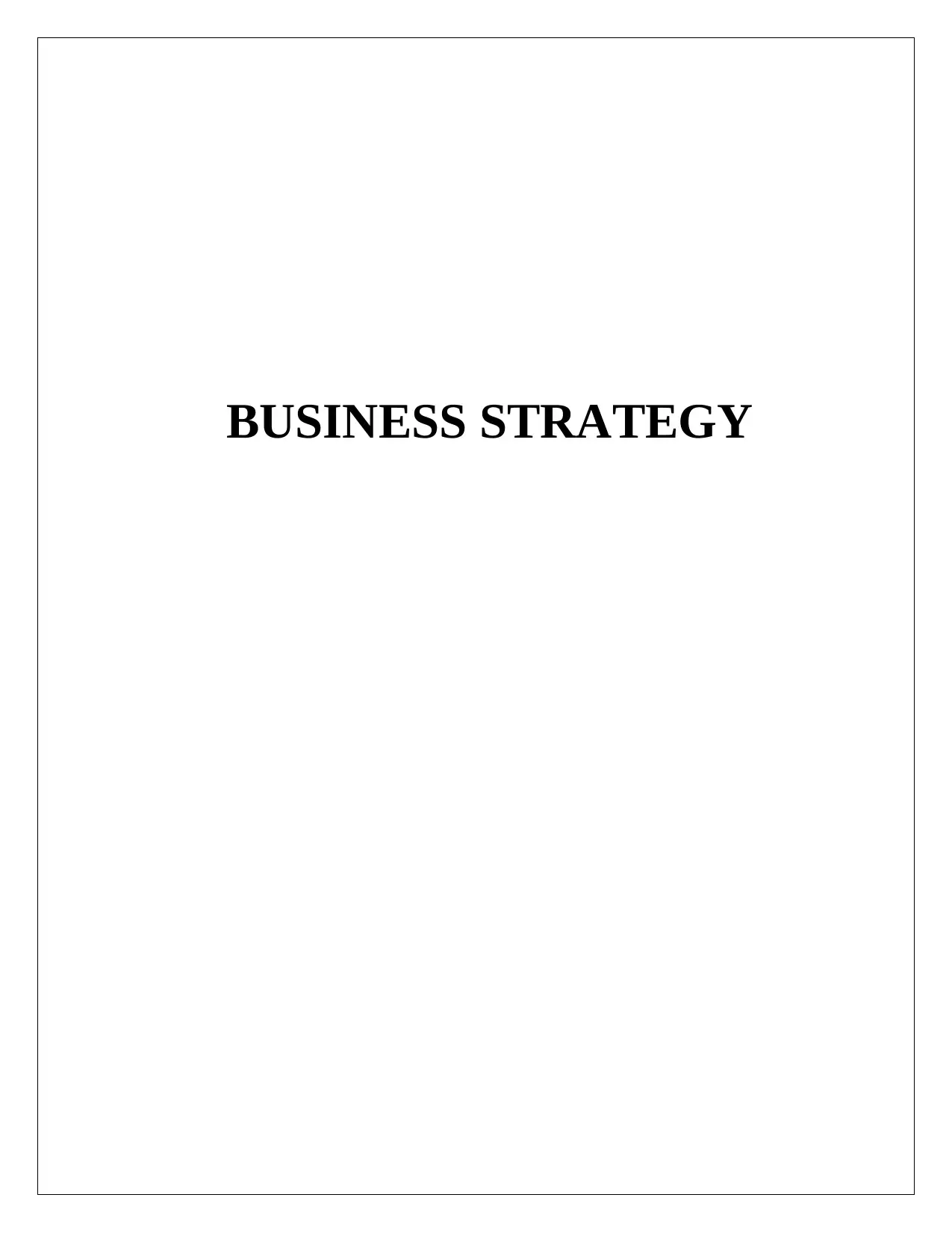
BUSINESS STRATEGY
Paraphrase This Document
Need a fresh take? Get an instant paraphrase of this document with our AI Paraphraser
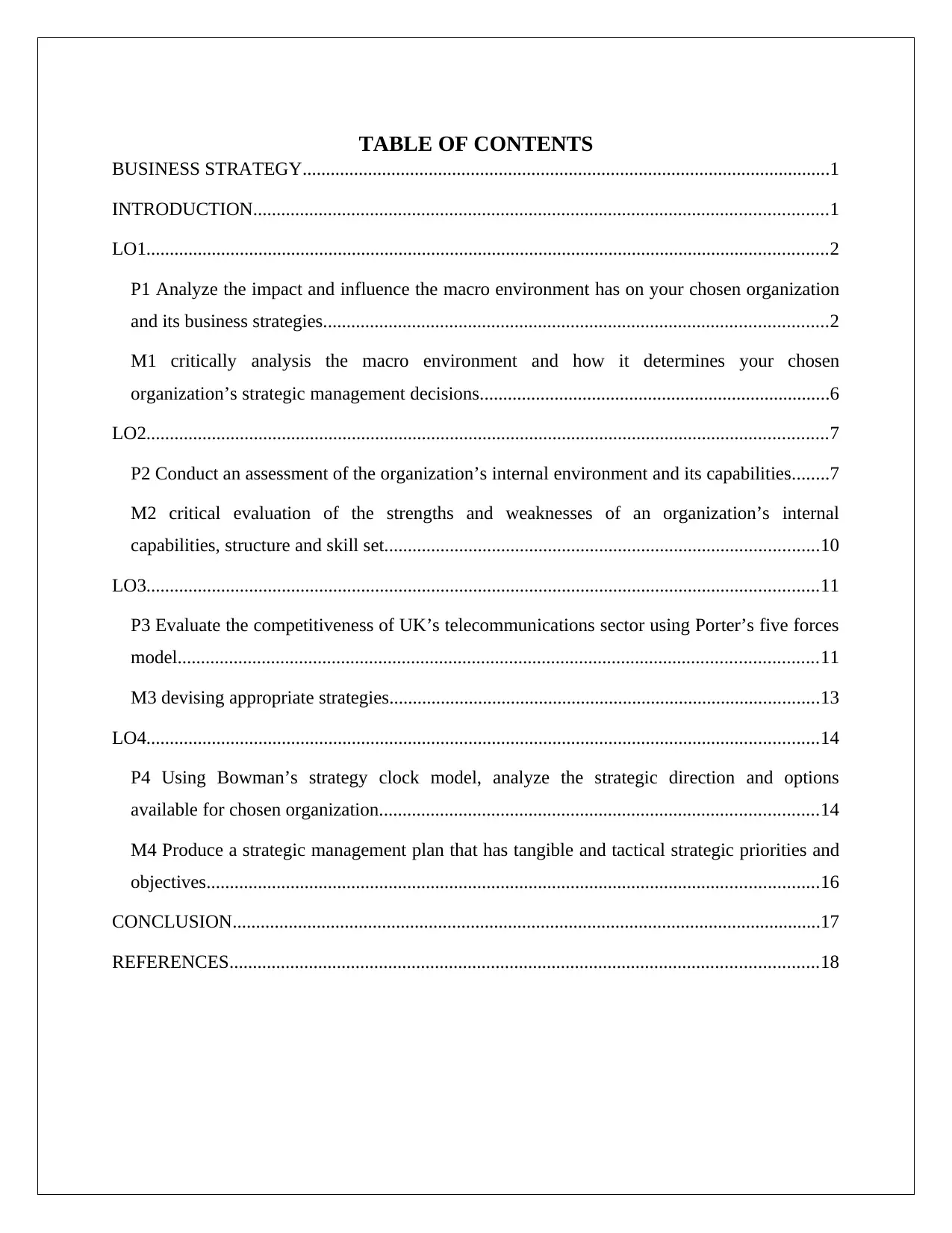
TABLE OF CONTENTS
BUSINESS STRATEGY.................................................................................................................1
INTRODUCTION...........................................................................................................................1
LO1..................................................................................................................................................2
P1 Analyze the impact and influence the macro environment has on your chosen organization
and its business strategies............................................................................................................2
M1 critically analysis the macro environment and how it determines your chosen
organization’s strategic management decisions...........................................................................6
LO2..................................................................................................................................................7
P2 Conduct an assessment of the organization’s internal environment and its capabilities........7
M2 critical evaluation of the strengths and weaknesses of an organization’s internal
capabilities, structure and skill set.............................................................................................10
LO3................................................................................................................................................11
P3 Evaluate the competitiveness of UK’s telecommunications sector using Porter’s five forces
model.........................................................................................................................................11
M3 devising appropriate strategies............................................................................................13
LO4................................................................................................................................................14
P4 Using Bowman’s strategy clock model, analyze the strategic direction and options
available for chosen organization..............................................................................................14
M4 Produce a strategic management plan that has tangible and tactical strategic priorities and
objectives...................................................................................................................................16
CONCLUSION..............................................................................................................................17
REFERENCES..............................................................................................................................18
BUSINESS STRATEGY.................................................................................................................1
INTRODUCTION...........................................................................................................................1
LO1..................................................................................................................................................2
P1 Analyze the impact and influence the macro environment has on your chosen organization
and its business strategies............................................................................................................2
M1 critically analysis the macro environment and how it determines your chosen
organization’s strategic management decisions...........................................................................6
LO2..................................................................................................................................................7
P2 Conduct an assessment of the organization’s internal environment and its capabilities........7
M2 critical evaluation of the strengths and weaknesses of an organization’s internal
capabilities, structure and skill set.............................................................................................10
LO3................................................................................................................................................11
P3 Evaluate the competitiveness of UK’s telecommunications sector using Porter’s five forces
model.........................................................................................................................................11
M3 devising appropriate strategies............................................................................................13
LO4................................................................................................................................................14
P4 Using Bowman’s strategy clock model, analyze the strategic direction and options
available for chosen organization..............................................................................................14
M4 Produce a strategic management plan that has tangible and tactical strategic priorities and
objectives...................................................................................................................................16
CONCLUSION..............................................................................................................................17
REFERENCES..............................................................................................................................18
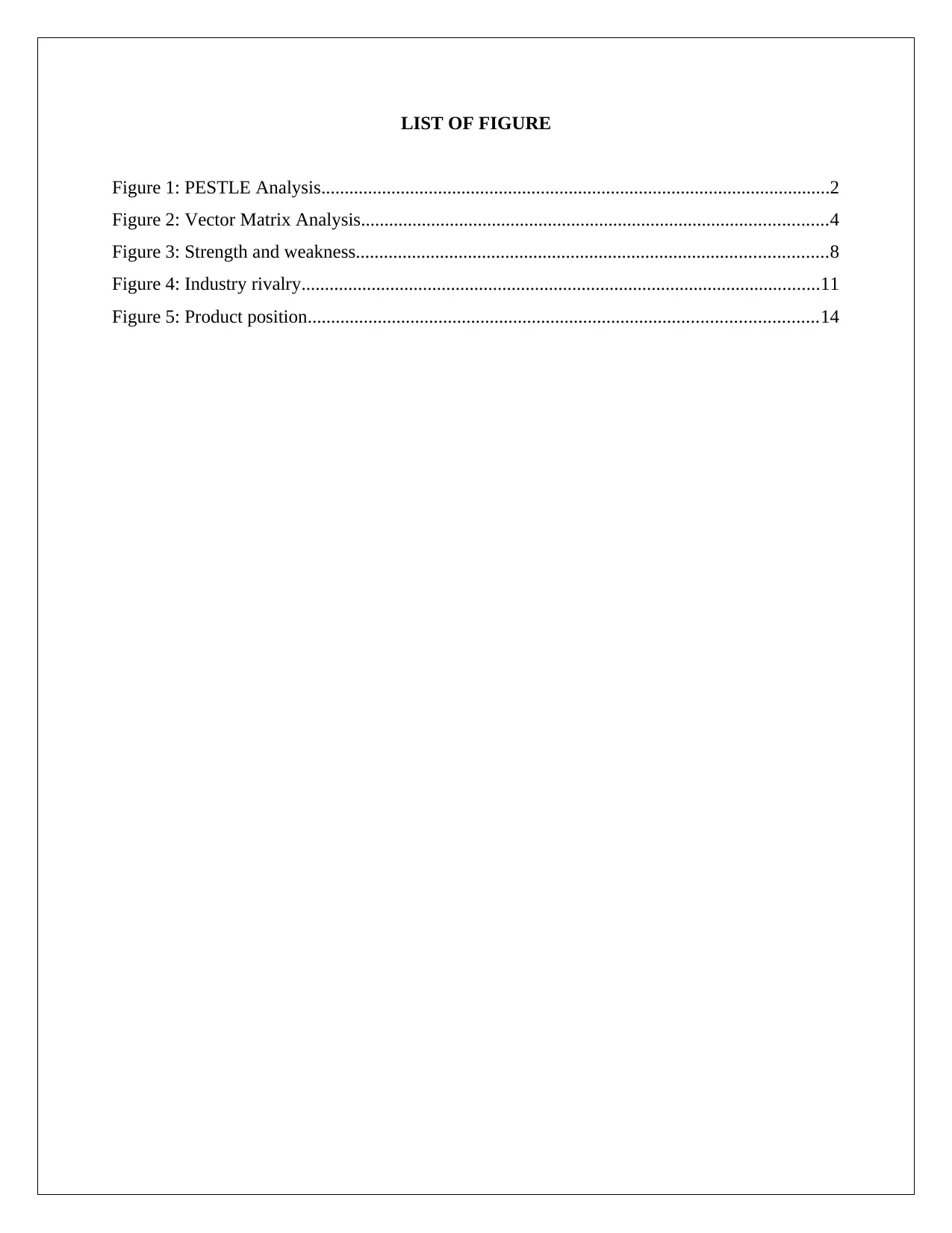
LIST OF FIGURE
Figure 1: PESTLE Analysis.............................................................................................................2
Figure 2: Vector Matrix Analysis....................................................................................................4
Figure 3: Strength and weakness.....................................................................................................8
Figure 4: Industry rivalry...............................................................................................................11
Figure 5: Product position.............................................................................................................14
Figure 1: PESTLE Analysis.............................................................................................................2
Figure 2: Vector Matrix Analysis....................................................................................................4
Figure 3: Strength and weakness.....................................................................................................8
Figure 4: Industry rivalry...............................................................................................................11
Figure 5: Product position.............................................................................................................14
⊘ This is a preview!⊘
Do you want full access?
Subscribe today to unlock all pages.

Trusted by 1+ million students worldwide
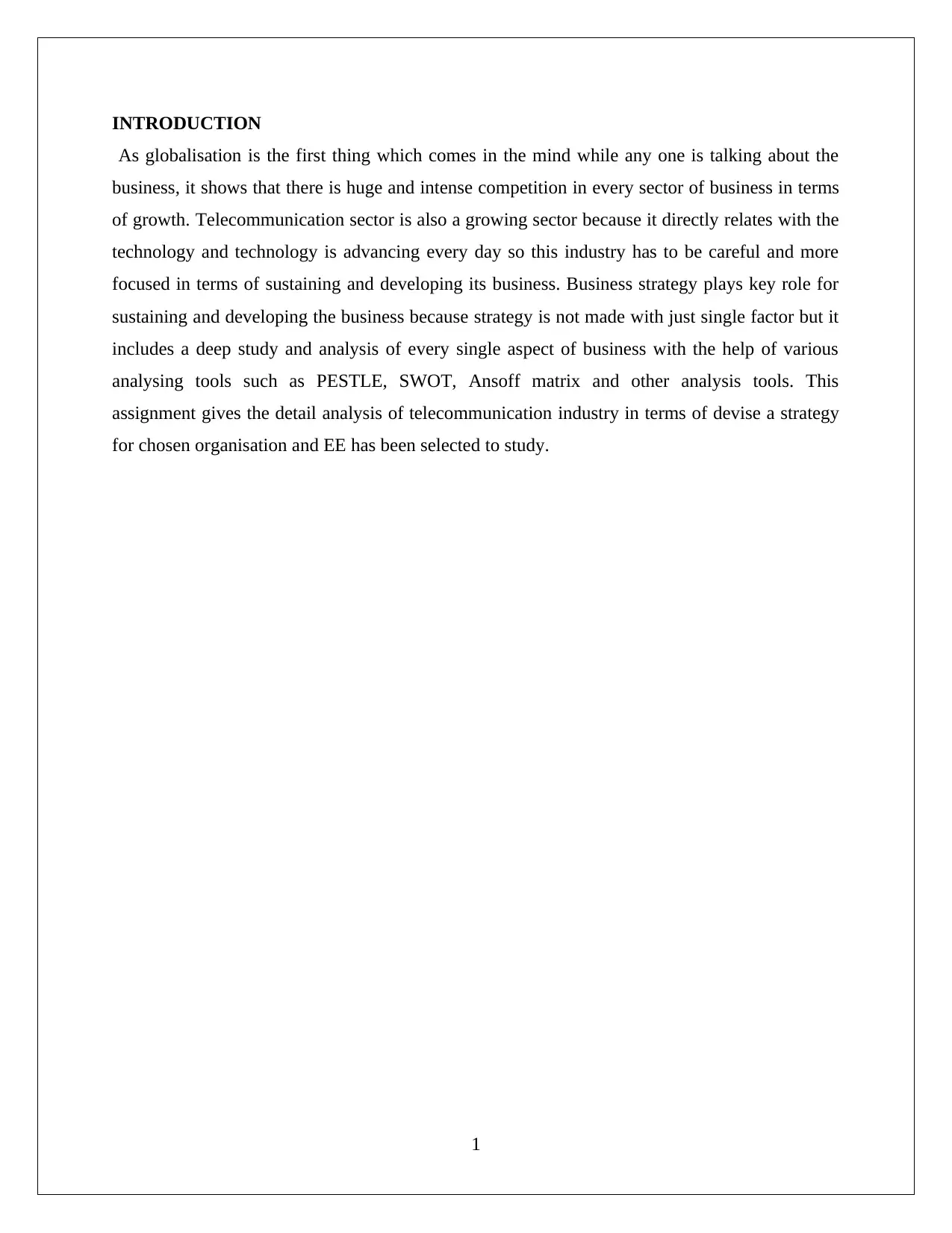
INTRODUCTION
As globalisation is the first thing which comes in the mind while any one is talking about the
business, it shows that there is huge and intense competition in every sector of business in terms
of growth. Telecommunication sector is also a growing sector because it directly relates with the
technology and technology is advancing every day so this industry has to be careful and more
focused in terms of sustaining and developing its business. Business strategy plays key role for
sustaining and developing the business because strategy is not made with just single factor but it
includes a deep study and analysis of every single aspect of business with the help of various
analysing tools such as PESTLE, SWOT, Ansoff matrix and other analysis tools. This
assignment gives the detail analysis of telecommunication industry in terms of devise a strategy
for chosen organisation and EE has been selected to study.
1
As globalisation is the first thing which comes in the mind while any one is talking about the
business, it shows that there is huge and intense competition in every sector of business in terms
of growth. Telecommunication sector is also a growing sector because it directly relates with the
technology and technology is advancing every day so this industry has to be careful and more
focused in terms of sustaining and developing its business. Business strategy plays key role for
sustaining and developing the business because strategy is not made with just single factor but it
includes a deep study and analysis of every single aspect of business with the help of various
analysing tools such as PESTLE, SWOT, Ansoff matrix and other analysis tools. This
assignment gives the detail analysis of telecommunication industry in terms of devise a strategy
for chosen organisation and EE has been selected to study.
1
Paraphrase This Document
Need a fresh take? Get an instant paraphrase of this document with our AI Paraphraser
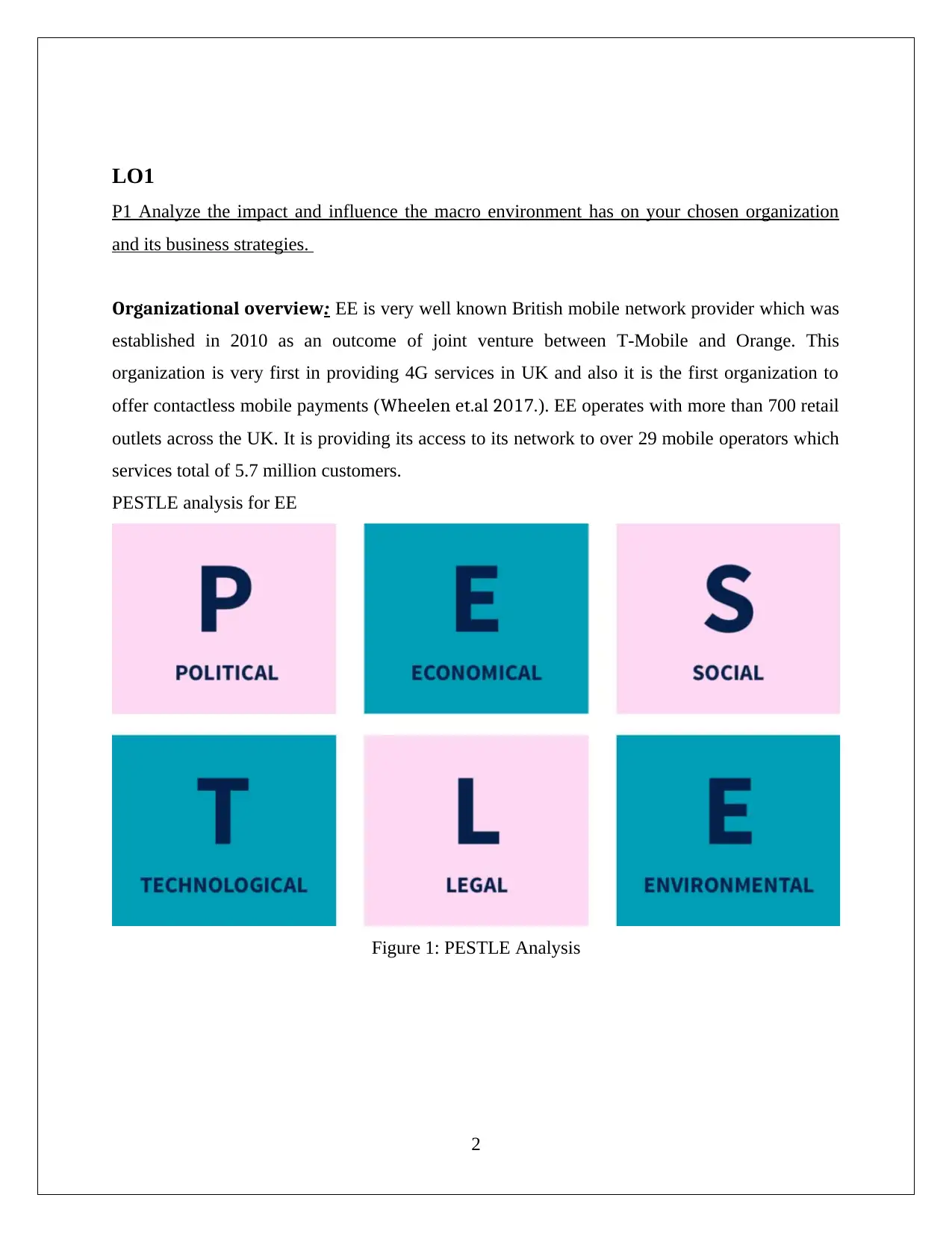
LO1
P1 Analyze the impact and influence the macro environment has on your chosen organization
and its business strategies.
Organizational overview: EE is very well known British mobile network provider which was
established in 2010 as an outcome of joint venture between T-Mobile and Orange. This
organization is very first in providing 4G services in UK and also it is the first organization to
offer contactless mobile payments (Wheelen et.al 2017.). EE operates with more than 700 retail
outlets across the UK. It is providing its access to its network to over 29 mobile operators which
services total of 5.7 million customers.
PESTLE analysis for EE
Figure 1: PESTLE Analysis
2
P1 Analyze the impact and influence the macro environment has on your chosen organization
and its business strategies.
Organizational overview: EE is very well known British mobile network provider which was
established in 2010 as an outcome of joint venture between T-Mobile and Orange. This
organization is very first in providing 4G services in UK and also it is the first organization to
offer contactless mobile payments (Wheelen et.al 2017.). EE operates with more than 700 retail
outlets across the UK. It is providing its access to its network to over 29 mobile operators which
services total of 5.7 million customers.
PESTLE analysis for EE
Figure 1: PESTLE Analysis
2
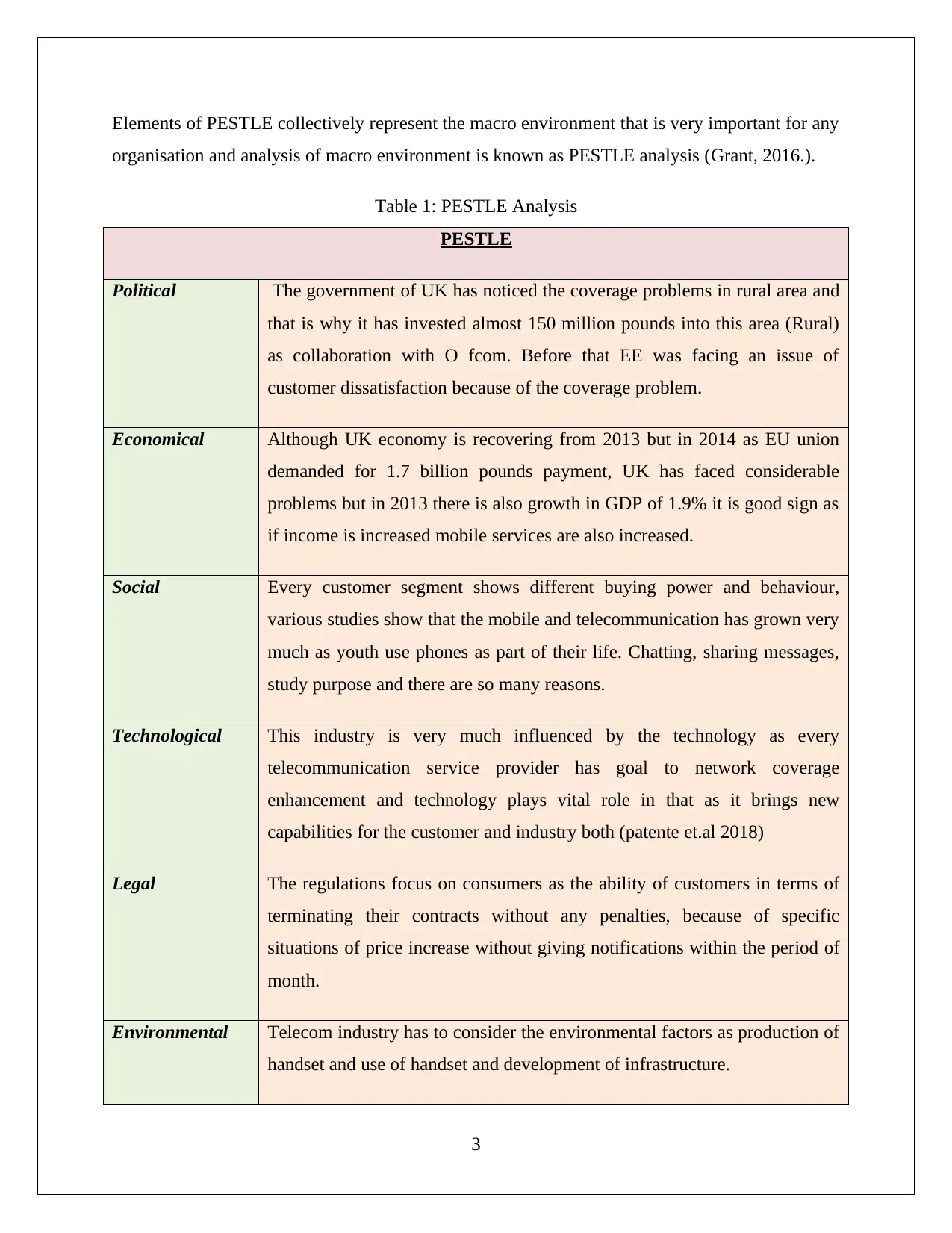
Elements of PESTLE collectively represent the macro environment that is very important for any
organisation and analysis of macro environment is known as PESTLE analysis (Grant, 2016.).
Table 1: PESTLE Analysis
PESTLE
Political The government of UK has noticed the coverage problems in rural area and
that is why it has invested almost 150 million pounds into this area (Rural)
as collaboration with O fcom. Before that EE was facing an issue of
customer dissatisfaction because of the coverage problem.
Economical Although UK economy is recovering from 2013 but in 2014 as EU union
demanded for 1.7 billion pounds payment, UK has faced considerable
problems but in 2013 there is also growth in GDP of 1.9% it is good sign as
if income is increased mobile services are also increased.
Social Every customer segment shows different buying power and behaviour,
various studies show that the mobile and telecommunication has grown very
much as youth use phones as part of their life. Chatting, sharing messages,
study purpose and there are so many reasons.
Technological This industry is very much influenced by the technology as every
telecommunication service provider has goal to network coverage
enhancement and technology plays vital role in that as it brings new
capabilities for the customer and industry both (patente et.al 2018)
Legal The regulations focus on consumers as the ability of customers in terms of
terminating their contracts without any penalties, because of specific
situations of price increase without giving notifications within the period of
month.
Environmental Telecom industry has to consider the environmental factors as production of
handset and use of handset and development of infrastructure.
3
organisation and analysis of macro environment is known as PESTLE analysis (Grant, 2016.).
Table 1: PESTLE Analysis
PESTLE
Political The government of UK has noticed the coverage problems in rural area and
that is why it has invested almost 150 million pounds into this area (Rural)
as collaboration with O fcom. Before that EE was facing an issue of
customer dissatisfaction because of the coverage problem.
Economical Although UK economy is recovering from 2013 but in 2014 as EU union
demanded for 1.7 billion pounds payment, UK has faced considerable
problems but in 2013 there is also growth in GDP of 1.9% it is good sign as
if income is increased mobile services are also increased.
Social Every customer segment shows different buying power and behaviour,
various studies show that the mobile and telecommunication has grown very
much as youth use phones as part of their life. Chatting, sharing messages,
study purpose and there are so many reasons.
Technological This industry is very much influenced by the technology as every
telecommunication service provider has goal to network coverage
enhancement and technology plays vital role in that as it brings new
capabilities for the customer and industry both (patente et.al 2018)
Legal The regulations focus on consumers as the ability of customers in terms of
terminating their contracts without any penalties, because of specific
situations of price increase without giving notifications within the period of
month.
Environmental Telecom industry has to consider the environmental factors as production of
handset and use of handset and development of infrastructure.
3
⊘ This is a preview!⊘
Do you want full access?
Subscribe today to unlock all pages.

Trusted by 1+ million students worldwide
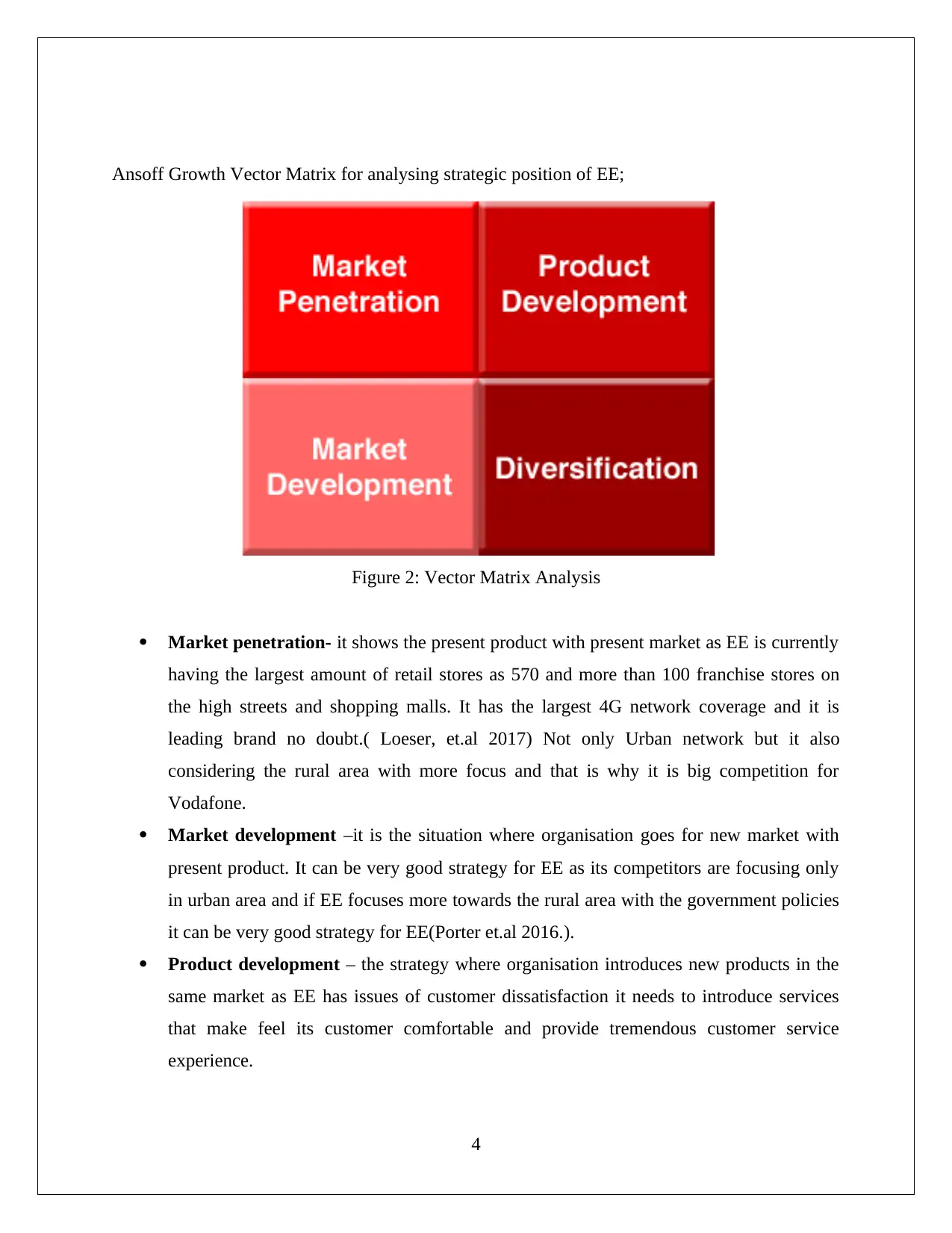
Ansoff Growth Vector Matrix for analysing strategic position of EE;
Figure 2: Vector Matrix Analysis
Market penetration- it shows the present product with present market as EE is currently
having the largest amount of retail stores as 570 and more than 100 franchise stores on
the high streets and shopping malls. It has the largest 4G network coverage and it is
leading brand no doubt.( Loeser, et.al 2017) Not only Urban network but it also
considering the rural area with more focus and that is why it is big competition for
Vodafone.
Market development –it is the situation where organisation goes for new market with
present product. It can be very good strategy for EE as its competitors are focusing only
in urban area and if EE focuses more towards the rural area with the government policies
it can be very good strategy for EE(Porter et.al 2016.).
Product development – the strategy where organisation introduces new products in the
same market as EE has issues of customer dissatisfaction it needs to introduce services
that make feel its customer comfortable and provide tremendous customer service
experience.
4
Figure 2: Vector Matrix Analysis
Market penetration- it shows the present product with present market as EE is currently
having the largest amount of retail stores as 570 and more than 100 franchise stores on
the high streets and shopping malls. It has the largest 4G network coverage and it is
leading brand no doubt.( Loeser, et.al 2017) Not only Urban network but it also
considering the rural area with more focus and that is why it is big competition for
Vodafone.
Market development –it is the situation where organisation goes for new market with
present product. It can be very good strategy for EE as its competitors are focusing only
in urban area and if EE focuses more towards the rural area with the government policies
it can be very good strategy for EE(Porter et.al 2016.).
Product development – the strategy where organisation introduces new products in the
same market as EE has issues of customer dissatisfaction it needs to introduce services
that make feel its customer comfortable and provide tremendous customer service
experience.
4
Paraphrase This Document
Need a fresh take? Get an instant paraphrase of this document with our AI Paraphraser
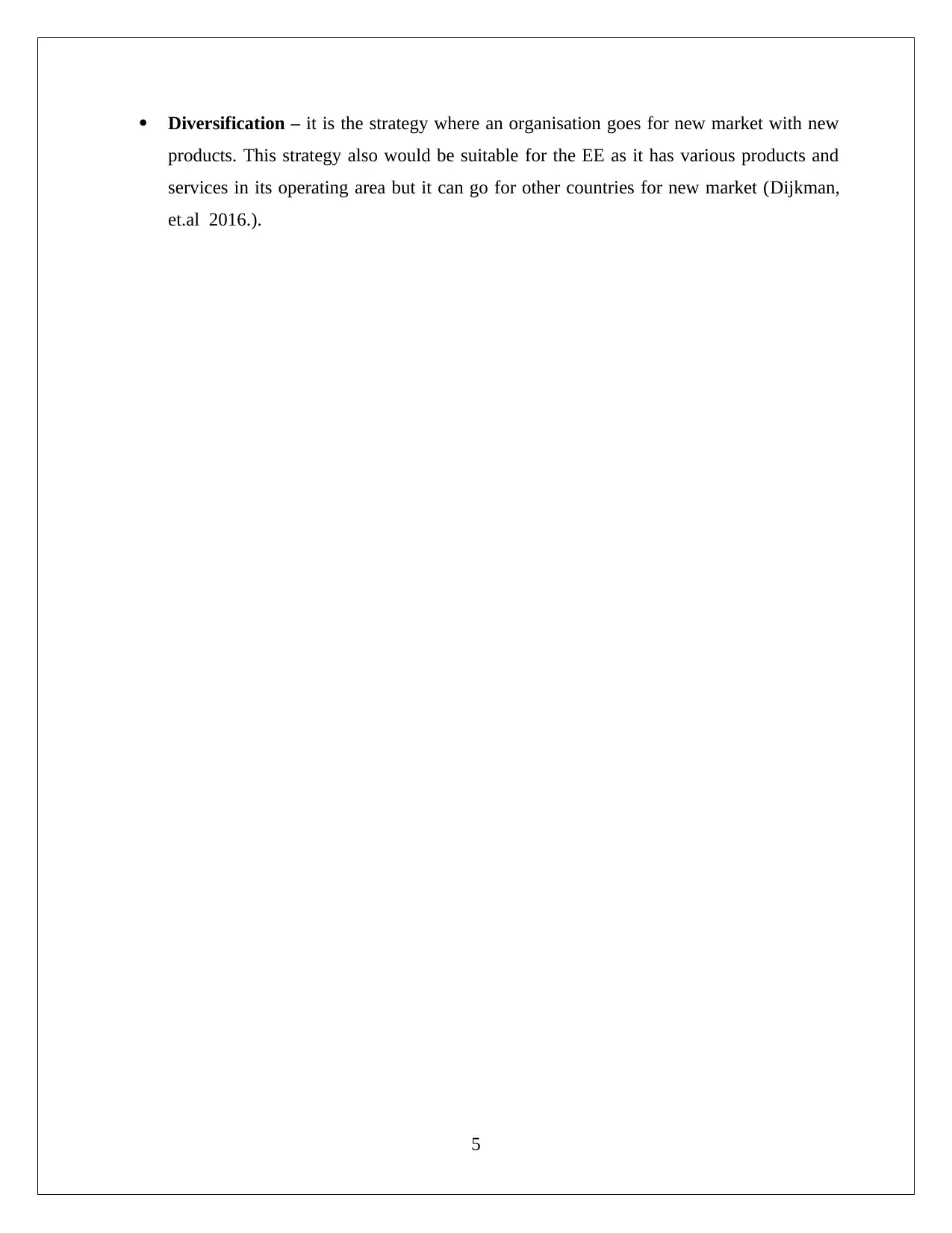
Diversification – it is the strategy where an organisation goes for new market with new
products. This strategy also would be suitable for the EE as it has various products and
services in its operating area but it can go for other countries for new market (Dijkman,
et.al 2016.).
5
products. This strategy also would be suitable for the EE as it has various products and
services in its operating area but it can go for other countries for new market (Dijkman,
et.al 2016.).
5
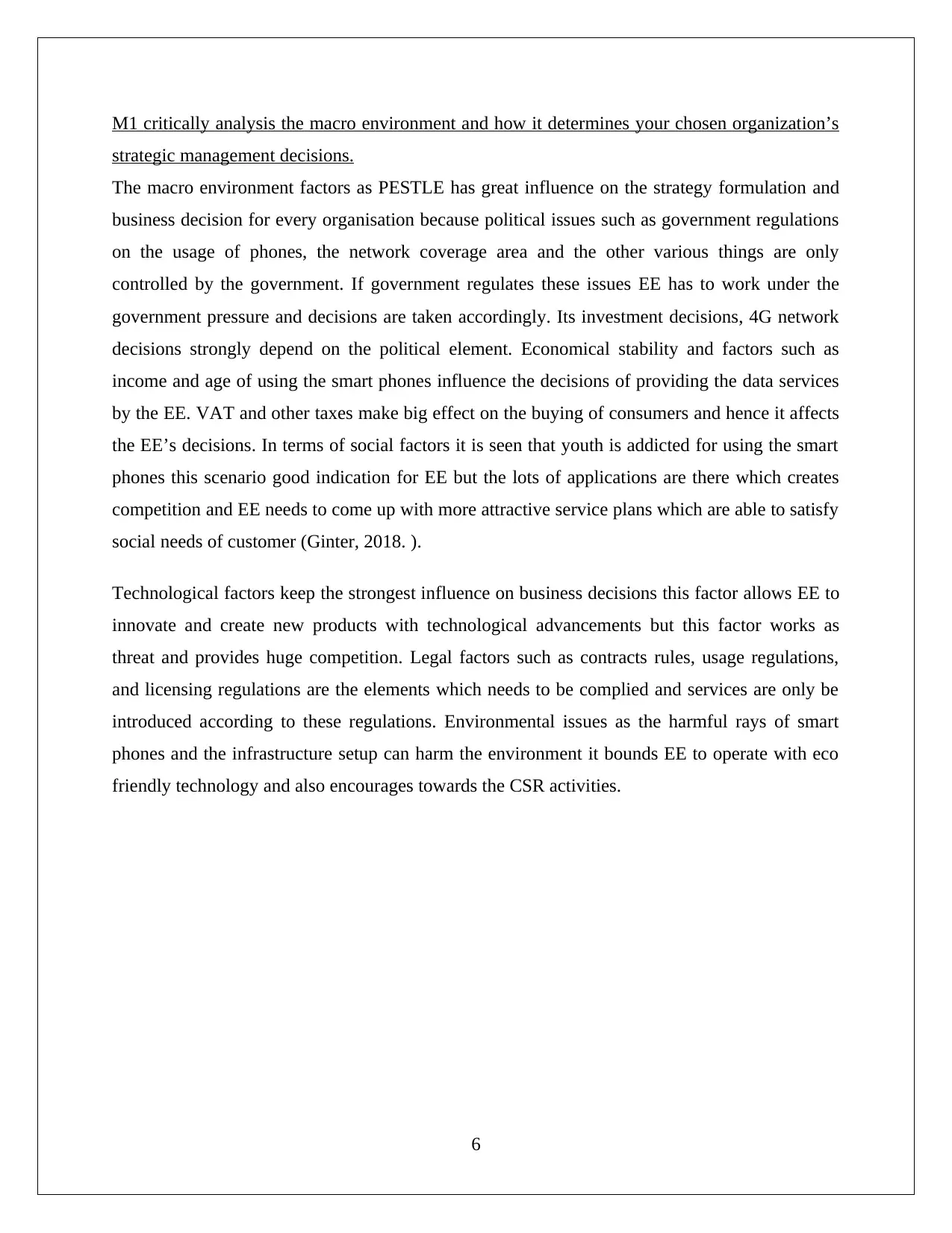
M1 critically analysis the macro environment and how it determines your chosen organization’s
strategic management decisions.
The macro environment factors as PESTLE has great influence on the strategy formulation and
business decision for every organisation because political issues such as government regulations
on the usage of phones, the network coverage area and the other various things are only
controlled by the government. If government regulates these issues EE has to work under the
government pressure and decisions are taken accordingly. Its investment decisions, 4G network
decisions strongly depend on the political element. Economical stability and factors such as
income and age of using the smart phones influence the decisions of providing the data services
by the EE. VAT and other taxes make big effect on the buying of consumers and hence it affects
the EE’s decisions. In terms of social factors it is seen that youth is addicted for using the smart
phones this scenario good indication for EE but the lots of applications are there which creates
competition and EE needs to come up with more attractive service plans which are able to satisfy
social needs of customer (Ginter, 2018. ).
Technological factors keep the strongest influence on business decisions this factor allows EE to
innovate and create new products with technological advancements but this factor works as
threat and provides huge competition. Legal factors such as contracts rules, usage regulations,
and licensing regulations are the elements which needs to be complied and services are only be
introduced according to these regulations. Environmental issues as the harmful rays of smart
phones and the infrastructure setup can harm the environment it bounds EE to operate with eco
friendly technology and also encourages towards the CSR activities.
6
strategic management decisions.
The macro environment factors as PESTLE has great influence on the strategy formulation and
business decision for every organisation because political issues such as government regulations
on the usage of phones, the network coverage area and the other various things are only
controlled by the government. If government regulates these issues EE has to work under the
government pressure and decisions are taken accordingly. Its investment decisions, 4G network
decisions strongly depend on the political element. Economical stability and factors such as
income and age of using the smart phones influence the decisions of providing the data services
by the EE. VAT and other taxes make big effect on the buying of consumers and hence it affects
the EE’s decisions. In terms of social factors it is seen that youth is addicted for using the smart
phones this scenario good indication for EE but the lots of applications are there which creates
competition and EE needs to come up with more attractive service plans which are able to satisfy
social needs of customer (Ginter, 2018. ).
Technological factors keep the strongest influence on business decisions this factor allows EE to
innovate and create new products with technological advancements but this factor works as
threat and provides huge competition. Legal factors such as contracts rules, usage regulations,
and licensing regulations are the elements which needs to be complied and services are only be
introduced according to these regulations. Environmental issues as the harmful rays of smart
phones and the infrastructure setup can harm the environment it bounds EE to operate with eco
friendly technology and also encourages towards the CSR activities.
6
⊘ This is a preview!⊘
Do you want full access?
Subscribe today to unlock all pages.

Trusted by 1+ million students worldwide
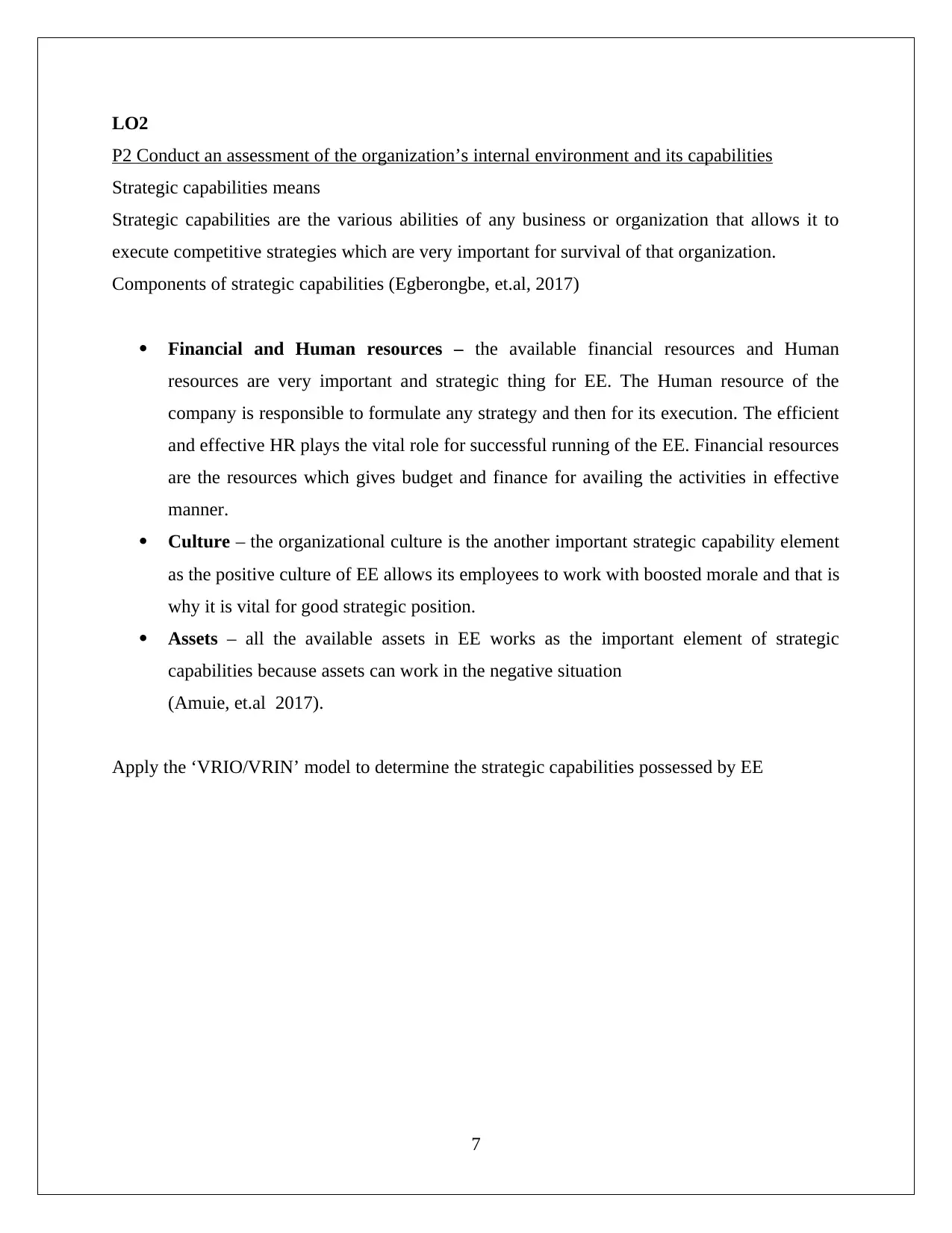
LO2
P2 Conduct an assessment of the organization’s internal environment and its capabilities
Strategic capabilities means
Strategic capabilities are the various abilities of any business or organization that allows it to
execute competitive strategies which are very important for survival of that organization.
Components of strategic capabilities (Egberongbe, et.al, 2017)
Financial and Human resources – the available financial resources and Human
resources are very important and strategic thing for EE. The Human resource of the
company is responsible to formulate any strategy and then for its execution. The efficient
and effective HR plays the vital role for successful running of the EE. Financial resources
are the resources which gives budget and finance for availing the activities in effective
manner.
Culture – the organizational culture is the another important strategic capability element
as the positive culture of EE allows its employees to work with boosted morale and that is
why it is vital for good strategic position.
Assets – all the available assets in EE works as the important element of strategic
capabilities because assets can work in the negative situation
(Amuie, et.al 2017).
Apply the ‘VRIO/VRIN’ model to determine the strategic capabilities possessed by EE
7
P2 Conduct an assessment of the organization’s internal environment and its capabilities
Strategic capabilities means
Strategic capabilities are the various abilities of any business or organization that allows it to
execute competitive strategies which are very important for survival of that organization.
Components of strategic capabilities (Egberongbe, et.al, 2017)
Financial and Human resources – the available financial resources and Human
resources are very important and strategic thing for EE. The Human resource of the
company is responsible to formulate any strategy and then for its execution. The efficient
and effective HR plays the vital role for successful running of the EE. Financial resources
are the resources which gives budget and finance for availing the activities in effective
manner.
Culture – the organizational culture is the another important strategic capability element
as the positive culture of EE allows its employees to work with boosted morale and that is
why it is vital for good strategic position.
Assets – all the available assets in EE works as the important element of strategic
capabilities because assets can work in the negative situation
(Amuie, et.al 2017).
Apply the ‘VRIO/VRIN’ model to determine the strategic capabilities possessed by EE
7
Paraphrase This Document
Need a fresh take? Get an instant paraphrase of this document with our AI Paraphraser
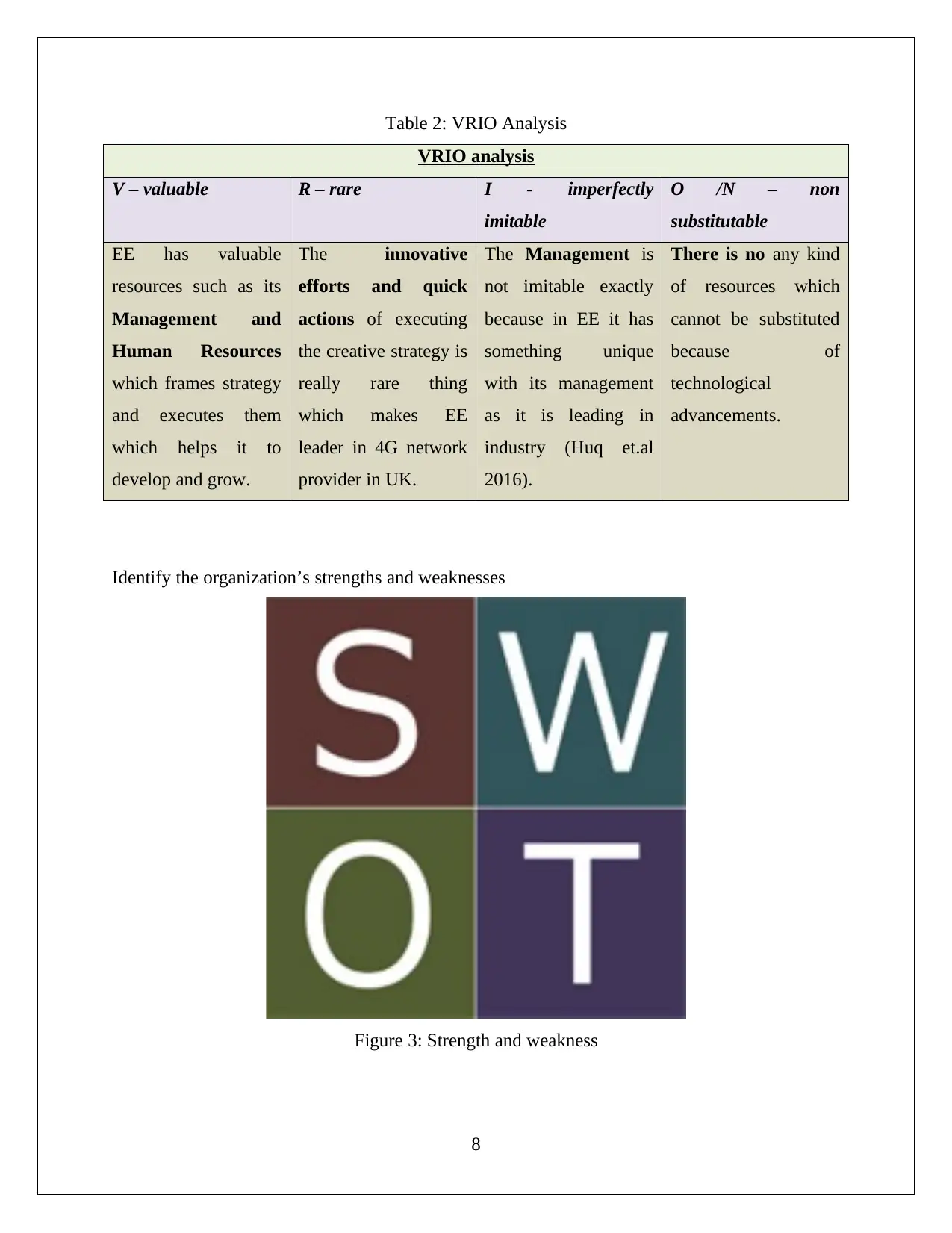
Table 2: VRIO Analysis
VRIO analysis
V – valuable R – rare I - imperfectly
imitable
O /N – non
substitutable
EE has valuable
resources such as its
Management and
Human Resources
which frames strategy
and executes them
which helps it to
develop and grow.
The innovative
efforts and quick
actions of executing
the creative strategy is
really rare thing
which makes EE
leader in 4G network
provider in UK.
The Management is
not imitable exactly
because in EE it has
something unique
with its management
as it is leading in
industry (Huq et.al
2016).
There is no any kind
of resources which
cannot be substituted
because of
technological
advancements.
Identify the organization’s strengths and weaknesses
Figure 3: Strength and weakness
8
VRIO analysis
V – valuable R – rare I - imperfectly
imitable
O /N – non
substitutable
EE has valuable
resources such as its
Management and
Human Resources
which frames strategy
and executes them
which helps it to
develop and grow.
The innovative
efforts and quick
actions of executing
the creative strategy is
really rare thing
which makes EE
leader in 4G network
provider in UK.
The Management is
not imitable exactly
because in EE it has
something unique
with its management
as it is leading in
industry (Huq et.al
2016).
There is no any kind
of resources which
cannot be substituted
because of
technological
advancements.
Identify the organization’s strengths and weaknesses
Figure 3: Strength and weakness
8
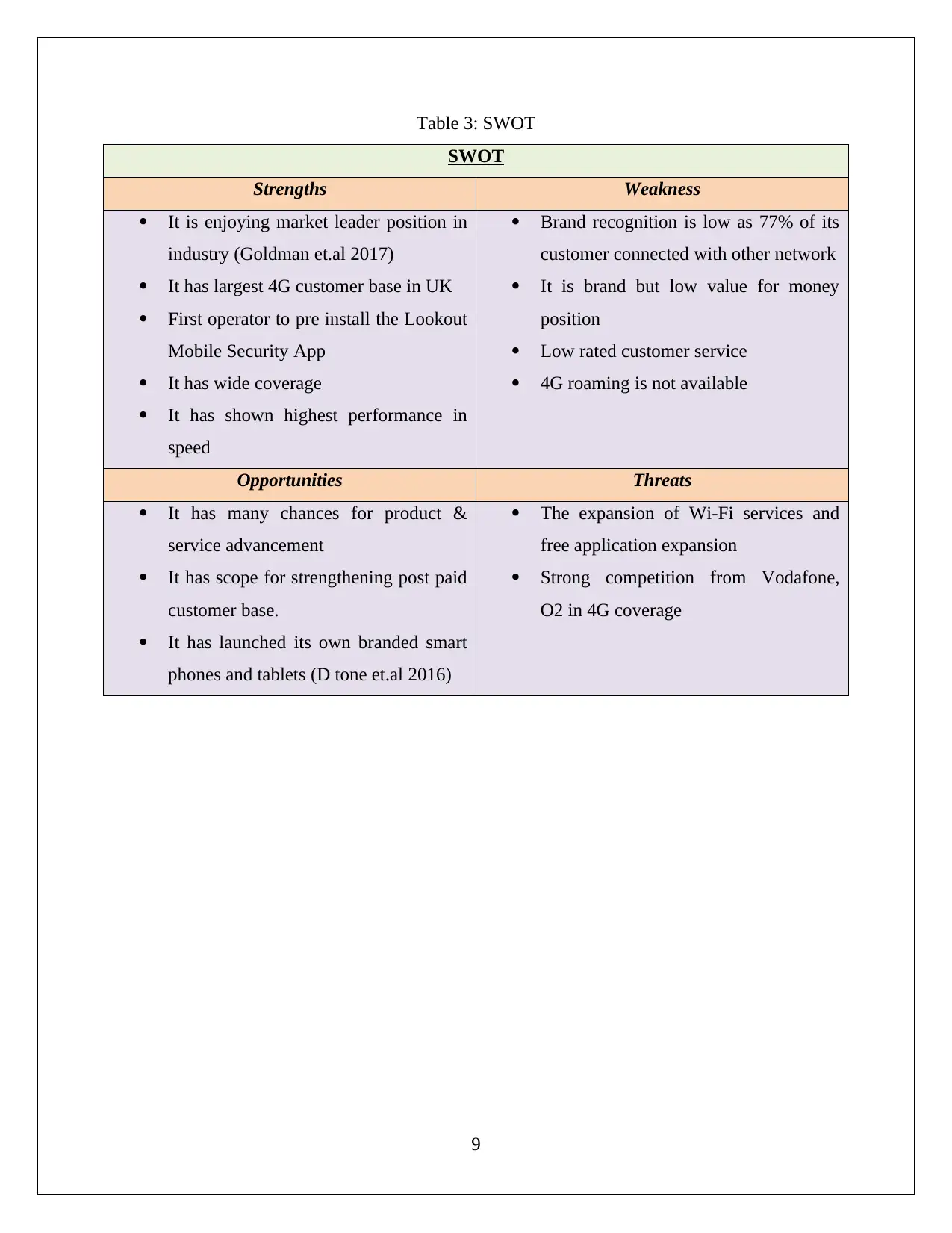
Table 3: SWOT
SWOT
Strengths Weakness
It is enjoying market leader position in
industry (Goldman et.al 2017)
It has largest 4G customer base in UK
First operator to pre install the Lookout
Mobile Security App
It has wide coverage
It has shown highest performance in
speed
Brand recognition is low as 77% of its
customer connected with other network
It is brand but low value for money
position
Low rated customer service
4G roaming is not available
Opportunities Threats
It has many chances for product &
service advancement
It has scope for strengthening post paid
customer base.
It has launched its own branded smart
phones and tablets (D tone et.al 2016)
The expansion of Wi-Fi services and
free application expansion
Strong competition from Vodafone,
O2 in 4G coverage
9
SWOT
Strengths Weakness
It is enjoying market leader position in
industry (Goldman et.al 2017)
It has largest 4G customer base in UK
First operator to pre install the Lookout
Mobile Security App
It has wide coverage
It has shown highest performance in
speed
Brand recognition is low as 77% of its
customer connected with other network
It is brand but low value for money
position
Low rated customer service
4G roaming is not available
Opportunities Threats
It has many chances for product &
service advancement
It has scope for strengthening post paid
customer base.
It has launched its own branded smart
phones and tablets (D tone et.al 2016)
The expansion of Wi-Fi services and
free application expansion
Strong competition from Vodafone,
O2 in 4G coverage
9
⊘ This is a preview!⊘
Do you want full access?
Subscribe today to unlock all pages.

Trusted by 1+ million students worldwide
1 out of 23
Related Documents
Your All-in-One AI-Powered Toolkit for Academic Success.
+13062052269
info@desklib.com
Available 24*7 on WhatsApp / Email
![[object Object]](/_next/static/media/star-bottom.7253800d.svg)
Unlock your academic potential
© 2024 | Zucol Services PVT LTD | All rights reserved.


